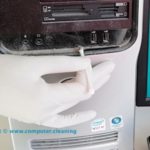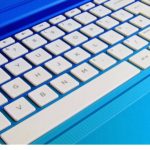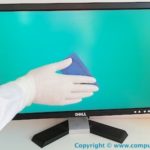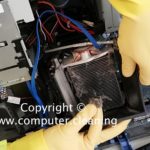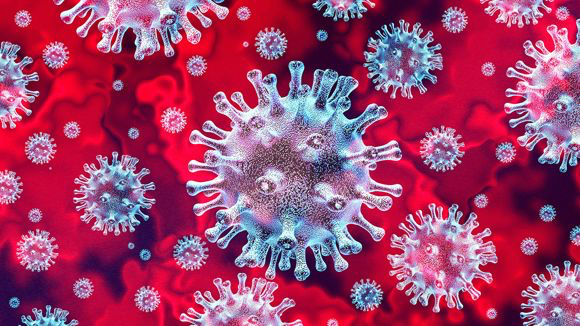
The coronavirus disinfection service for computers, laptops, keyboards, monitor screens, and telephone sets focuses on deep cleaning of the computer equipment form coronavirus. Due to the current outbreak of coronavirus in London and across the UK, it has been observed that computers, laptops, keyboards, Monitor Screens, and telephone sets in your office environment can be an ideal carrier of coronavirus if not disinfected correctly.
How Coronavirus (COVID-19) contamination is spread through your office computer equipment and keyboard?
At your office, you spend most of your time typing on your computer keyboard and touching your PC mouse. You also get in close contact with other parts of your computer equipment i.e. monitor screens, trackpad, telephone sets, headphones, etc.
Considering the current outbreak situation of the coronavirus in London and across the UK, sneezing directly over your keyboard when you have the coronavirus infection (COVID-19) means that your flu virus is now also lodged in between the keys.
Most of the time coronavirus, germs, microbes are likely to be picked up through hand contact with your computer keyboard and mouse if not disinfected and deep cleaned correctly and thus become a medium of spreading coronavirus from human to human.
Do’s to Avoid Catching and Spreading Coronavirus
- wash your hands with soap and water often – do this for at least 20 seconds
- always wash your hands when you get home or into work
- use hand sanitiser gel if soap and water are not available
- cover your mouth and nose with a tissue or your sleeve (not your hands) when you cough or sneeze
- put used tissues in the bin immediately and wash your hands afterward
- avoid close contact with people who have symptoms of coronavirus
- only travel on public transport if you need to
- work from home, if you can
- avoid social activities, such as going to pubs, restaurants, theatres, and cinemas
- avoid events with large groups of people
- use the phone, online services, or apps to contact your GP surgery or other NHS services
Don’t’s to Avoid Catching and Spreading Coronavirus
- do not touch your eyes, nose or mouth if your hands are not clean
- do not have visitors to your home, including friends and family
More information
- GOV.UK: coronavirus action plan
- GOV.UK: information on coronavirus and the situation in the UK
- NHS England: coronavirus for health professionals
Cleaning and Disinfection After Persons Suspected/Confirmed to Have COVID-19 Have Been in the Facility
Timing and location of cleaning and disinfection of surfaces
- At a school, daycare centre, office, or other facilities that do not house people overnight:
- It is recommended to close off areas used by the ill persons and wait as long as practical before beginning cleaning and disinfection to minimize potential for exposure to respiratory droplets. Open outside doors and windows to increase air circulation in the area. If possible, wait up to 24 hours before beginning cleaning and disinfection.
- Cleaning staff should clean and disinfect all areas (e.g., offices, bathrooms, and common areas) used by the ill persons, focusing especially on frequently touched surfaces.
- At a facility that does house people overnight:
- Follow Interim Guidance for US Institutions of Higher Education on working with state and local health officials to isolate ill persons and provide temporary housing as needed.
- It is recommended to close off areas used by the ill persons and wait as long as practical before beginning cleaning and disinfection to minimize potential for exposure to respiratory droplets. Open outside doors and windows to increase air circulation in the area. If possible, wait up to 24 hours before beginning cleaning and disinfection.
- In areas where ill persons are being housed in isolation, follow Interim Guidance for Environmental Cleaning and Disinfection for U.S. Households with Suspected or Confirmed Coronavirus Disease 2019. This includes focusing on cleaning and disinfecting common areas where staff/others providing services may come into contact with ill persons, but reducing cleaning and disinfection of bedrooms/bathrooms used by ill persons to as needed.
- In areas where ill persons have visited or used, continue routine cleaning and disinfection as in this guidance.
How to Clean and Disinfect
Surfaces
- If surfaces are dirty, they should be cleaned using a detergent or soap and water prior to disinfection.
- For disinfection, diluted household bleach solutions, alcohol solutions with at least 70% alcohol, and most common EPA-registered household disinfectants should be effective.
- Diluted household bleach solutions can be used if appropriate for the surface. Follow manufacturer’s instructions for application and proper ventilation. Check to ensure the product is not past its expiration date. Never mix household bleach with ammonia or any other cleanser. Unexpired household bleach will be effective against coronaviruses when properly diluted.
- Prepare a bleach solution by mixing:
- 5 tablespoons (1/3rd cup) bleach per gallon of water or
- 4 teaspoons bleach per quart of water
- Products with EPA-approved emerging viral pathogens claimsexternal icon are expected to be effective against COVID-19 based on data for harder to kill viruses. Follow the manufacturer’s instructions for all cleaning and disinfection products (e.g., concentration, application method and contact time, etc.).
- For soft (porous) surfaces such as carpeted floor, rugs, and drapes, remove visible contamination if present and clean with appropriate cleaners indicated for use on these surfaces. After cleaning:
- If the items can be laundered, launder items in accordance with the manufacturer’s instructions using the warmest appropriate water setting for the items and then dry items completely.
- Otherwise, use products with the EPA-approved emerging viral pathogens claims (examples at this linkpdf iconexternal icon) that are suitable for porous surfaces
Linens, Clothing, and Other Items That Go in the Laundry
- Do not shake dirty laundry; this minimize the possibility of dispersing virus through the air.
- Wash items as appropriate in accordance with the manufacturer’s instructions. If possible, launder items using the warmest appropriate water setting for the items and dry items completely. Dirty laundry that has been in contact with an ill person can be washed with other people’s items.
- Clean and disinfect hampers or other carts for transporting laundry according to the guidance above for hard or soft surfaces.
Personal Protective Equipment (PPE) and Hand Hygiene
- Cleaning staff should wear disposable gloves and gowns for all tasks in the cleaning process, including handling trash.
- Gloves and gowns should be compatible with the disinfectant products being used.
- Additional PPE might be required based on the cleaning/disinfectant products being used and whether there is a risk of a splash.
- Gloves and gowns should be removed carefully to avoid contamination of the wearer and the surrounding area. Be sure to clean your hands after removing gloves.
- Gloves should be removed after cleaning a room or area occupied by ill persons. Clean hands immediately after gloves are removed.
- Cleaning staff should immediately report breaches in PPE (e.g., tear in gloves) or any potential exposures to their supervisor.
- Cleaning staff and others should clean hands often, including immediately after removing gloves and after contact with an ill person, by washing hands with soap and water for 20 seconds. If soap and water are not available and hands are not visibly dirty, an alcohol-based hand sanitizer that contains 60%-95% alcohol may be used. However, if hands are visibly dirty, always wash hands with soap and water.
- Follow normal preventive actions while at work and home, including cleaning hands and avoiding touching eyes, nose, or mouth with unwashed hands.
- Additional key times to clean hands include:
- After blowing one’s nose, coughing, or sneezing
- After using the restroom
- Before eating or preparing food
- After contact with animals or pets
- Before and after providing routine care for another person who needs assistance (e.g., a child)
- Additional key times to clean hands include:
Additional Considerations for Employers
- Employers should work with their local and state health departments to ensure appropriate local protocols and guidelines, such as updated/additional guidance for cleaning and disinfection, are followed, including for identification of new potential cases of COVID-19.
- Employers should educate staff and workers performing cleaning, laundry, and trash pick-up activities to recognize the symptoms of COVID-19 and provide instructions on what to do if they develop symptoms within 14 days after their last possible exposure to the virus. At a minimum, any staff should immediately notify their supervisor and the local health department if they develop symptoms of COVID-19. The health department will provide guidance on what actions need to be taken. When working with your local health department check their available hours.
- Employers should develop policies for worker protection and provide training to all cleaning staff on site prior to providing cleaning tasks. Training should include when to use PPE, what PPE is necessary, how to properly don (put on), use, and doff (take off) PPE, and how to properly dispose of PPE.
- Employers must ensure workers are trained on the hazards of the cleaning chemicals used in the workplace in accordance with OSHA’s Hazard Communication standard (29 CFR 1910.1200external icon).
- Employers must comply with OSHA’s standards on Bloodborne Pathogens (29 CFR 1910.1030external icon), including proper disposal of regulated waste, and PPE (29 CFR 1910.132external icon).
Additional Resources
Coronavirus (COVID-19): UK government response
COVID-19 is a new illness that can affect your lungs and airways. It’s caused by a type of coronavirus.
Find out how to protect yourself or check if you need medical help on the NHS website
Guidance for employers and businesses
Number of coronavirus (COVID-19) cases and risk in the UK

